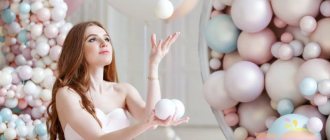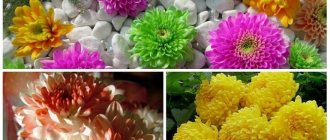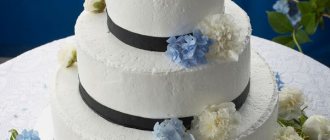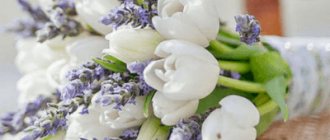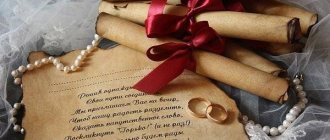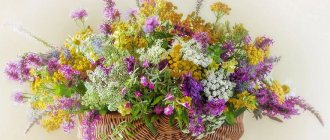A beautiful bouquet is a universal means of expressing feelings and the result of painstaking work, which is carried out according to certain rules. Every detail is important in its design, from the selection of colors to their arrangement and packaging. We'll figure out what needs to be taken into account when choosing flowers so that the bouquet matches the occasion, how to beautifully pack flowers and what can serve as original packaging.
Festive bouquet in multi-layer packaging Source pinimg.com
Choice of colors: type, color and quantity
Whether we like it or not, flowers for bouquets are collected based on unspoken rules, and the choice is often strictly taboo. Everything in a bouquet is important: the type of plants, their color and quantity depend on the occasion of the gift. It is interesting that different nations often have rules that contradict each other.
Before assembling a beautiful bouquet of fresh flowers, the donor has to remember the language of flowers - the symbolic meaning of certain types. Florists are well aware of it; in their work they use this and other proven recipes for making flower arrangements.
Peonies Source akspic.ru
About the meaning
Certain flowers symbolize certain feelings, but their expression is influenced not only by the type of plant, but also by its color. In different countries, color occasions are often opposite. For example, we have a white bouquet - a symbol of sympathy and location without any double meanings; such a gift is presented to a relative, young girl or colleague.
And in Japan, China and other Asian countries, white flowers are presented as a sign of mourning. This, in turn, causes misunderstanding in Russia, where red carnations are considered mourning, and the choice of flowers for bouquets is subject to strict symbolic meanings.
Summer composition Source akspic.ru
Red buds (especially roses) symbolize passion, and throughout Europe are perceived as a declaration of love. Therefore, bouquets for friends and colleagues include buds of less saturated tones, or red roses are diluted with other shades. It is interesting that in Latin American traditions, the color red symbolizes blood and death, so it is customary to explain feelings here using white or soft pink roses.
In Europe, not only carnations, but also poppies and chrysanthemums are considered flowers of mourning. In our culture, stereotypes have shifted, and chrysanthemums are given to teachers on September 1, and in Japan they are a symbol of the imperial dynasty. In order not to violate etiquette, it is useful to know how to arrange a bouquet of flowers, for which you need to take into account the following symbolism:
- Chrysanthemum symbolizes longevity and good health.
With lavender and dried flowers Source kupit-cvetov.ru
- Cloves have a second meaning. This is a male flower, a symbol of perseverance and nobility. Tall and graphic plants have the same meaning: gladiolus and iris (if it is blue or lilac).
- Graceful, delicately scented lilies of the valley, lilacs or violets express freshness, fragility, and youth.
- Lily is a symbol of luxury, grandeur and nobility.
- Chamomiles and gerberas are an unobtrusive symbol of good location and interest.
- Yellow inflorescences have a difficult reputation, but you can ignore it, especially if you combine yellow with other shades.
Boutonnieres Source hotwed.com.ua
About quantity
In Russia, everyone knows that a bouquet can be as large as desired, but it must contain an odd number of flowers. If the bouquet contains 4, 6 or 8 flowers, the reason for purchase is far from the most joyful. The rule does not exist in Europe, where they easily give any number of flowers for any occasion. Most likely, an odd number creates an asymmetry that looks more natural and, therefore, aesthetically pleasing.
In lilac colors Source nevesta.info
Colors of the bouquet
There are three main colors used in floristry:
- Yellow.
- Red.
- Blue.
Green acts as a decor, but the center of the composition is always captured by the representatives of the trio. They organically complement each other. Yellow and red are warm, sunny colors. Blue and its shades (blue, violet, lilac) are cool tones. The color temperature of green is also quite “low”. Pay attention to bouquets consisting exclusively of blue flowers. They look strict and unapproachable. The coldness of the blue is greatly enhanced by the surrounding greenery. It is enough to add a couple of warm yellow, orange, red notes to the bouquet and the composition is filled with inner light, its “mood” changes dramatically. Neutral white can set off the brightness of its neighbors or be used on its own in delicate bouquets. For example, white roses do not need any additions.
Decorated with a sprig of asparagus and wrapped in an envelope made of transparent film, they become the personification of luxurious laconicism. Plain bouquets of delicate flowers (pink, white, pale yellow) can be diluted with notes of greenery. The blue color combines perfectly with yellow, and one of its shades, blue, with soft pink. Another elegant, win-win combination is white and red.
How to compose a composition
To know how to beautifully arrange a bouquet of flowers at home, you need to become familiar with the composition techniques developed by florists. Beautiful and harmonious bouquets are formed according to the following principles:
- Parallel technology. Suitable for decorating vertical (often “masculine”) compositions, for which flowers with large buds are used. Plants are laid in a ladder; a cascade of several rows is obtained. There is no central point in the composition; all rows are equal and narrow towards the top.
Parallel technology Source whiterosemodernfunerals.co.uk
See also: Catalog of companies that specialize in winter gardens
- Spiral technique. The most common method. The base is a flower, around which other buds are placed with a slight tilt. After assembly, a spiral is formed, which can be seen by looking at the bouquet from above. Plants with long and fairly dense stems are suitable for this technique.
- Boutonniere. A mini bouquet of several buds, a traditional accessory for a men's suit. The boutonniere is inserted into the buttonhole on special occasions: at graduation, anniversary, wedding; sometimes it is attached to a woman's bracelet. The boutonniere is made neat for ease of wearing. The composition consists of a central large flower and additional decorative elements.
Spiral technique Source bloomnation.com
- Biedermeier. Traditionally, this is a dome-shaped bouquet (wedding), but there are flattened, spherical and pyramidal options. The technique has German roots, so the beautiful packaging of flowers is complemented by a variety of decor: ribbons, lace, brooches. In the modern version, the buds are placed on a special holder; It holds a sponge with water to keep it fresh.
- Asymmetrical technique. The composition is formed around one element, the rest differ in shape and height. The technique is considered complex, as it requires knowledge of the principles of floristry, the ability to apply them in practice and imagination.
Biedermeier Source secureservercdn.net
For a special occasion
If the bouquet is intended for the bride or for another occasion when it does not have to stand quietly in a vase from the very beginning (transportation, presentation, carrying in hands, etc.), additional fixation will be required. For this, there is a special floral glue, thanks to which the structure will not fall apart even when riding a motorcycle on a country road. Apply the same glue to the cuts on the stems. This will allow moisture to be retained, and the bouquet will live without water for a longer time.
Doesn't have to be a circle!
A bouquet assembled in a spiral pattern does not necessarily have to have a classic shape. If you master this technique well, you can lay out, for example, a heart. In this case, the design is created without a central, apical flower. If you make the interception low, the flower cap will take the shape of a circle. It can be either hollow inside or “filled.” To make a heart, you will need fairly hard wire.
It needs to be braided around the stems at the base of the buds, and then bent into the shape of a heart. You can place a gift in the center of such a composition. But it should be borne in mind that it should be very light - for example, Raffaello candies.
How to combine different types
Gone are the times when flowers were tied to strictly defined occasions and holidays (for example, mimosas were given strictly on March 8), which was mainly due to the seasonality of cultivation. Globalization has also reached floristry: any plants, including exotic ones, are available all year round.
Assembling a bouquet Source wp.com
Even in the middle of winter, it has become possible to arrange bouquets of flowers of all types and varieties. But the most beautiful plants are only half of a truly beautiful bouquet. In order for the composition to look harmonious, it is necessary to take into account the structure, that is, the shape and size of the buds, inflorescences and leaves. According to this parameter, five groups are distinguished:
- Big ones. Plants that will dominate the composition. They try not to mix them with each other, but complement them with medium colors to achieve splendor and expressiveness. The group includes large chrysanthemums, lilies, peonies; this also includes delphinium and gladioli.
Bouquet for the bride Source pinimg.com
Basic recommendations
Many people prefer to use the services of a professional florist for their wedding. However, if the bride has a desire to create and free time, then the bouquet can be assembled with her own hands. In this case, you will be able to save a little.
Before you start creating, do not overestimate your capabilities and be sure to listen to the advice of professionals.
- No complicated designs.
- The lighter the better. The bride will have to carry flowers for at least half a day. That is why the composition should not be too heavy.
- Combination with the image. The bouquet should harmoniously emphasize the advantages and veil the shortcomings of the bride's image. The more luxurious the dress, the more laconic the bouquet. A small flower ball is suitable for petite girls, a cascade is suitable for tall brides, and representatives of the fair half of humanity with curvaceous figures should choose the same design.
Note: superstitious florists recommend using 19 flowers to assemble a wedding bouquet. This amount symbolizes a long, happy life together.
The final stage: packaging
For quite a long time, no special importance was attached to the design of packaging for bouquets of fresh flowers; its role was played by transparent cellophane. Later, packaging made of bright corrugated paper, fancifully decorated with prints and scallops, and complemented with floral mesh, became a sign of good taste.
Peonies in craft paper Source flowerbulbs.nl
To date, there has been a trend towards the use of more discreet and sophisticated packaging for flowers; Florists know how to properly arrange a bouquet. They offer a lot of interesting materials. The following options are common:
- Paper. Paper packaging is still in trend due to its practicality and variety. It can be monochromatic, with thematic patterns and reliefs; Kraft paper is gaining popularity. Texture types are interesting: corrugated, waffle, crinkled, crepe. Korean packaging (tracing paper) is becoming popular, which does not wrinkle and gracefully deforms around the bouquet.
Corrugated paper Source prom.st
- Fabrics. Elegant and soft artificial linen goes well with any floral arrangements. Rough jute burlap made from natural raw materials is suitable for exotic flowers. Floral felt, light and moderately dense, is suitable for both voluminous, tall bouquets and small buds.
Bouquet in burlap Source wallbox.ru
Spiral technique
This option appeared much later; it belongs to modern floristic trends. In the spiral technique of assembling a bouquet, start with the central bud. But three flowers can also act as the center at the same time. The assembly diagram is carried out in the left hand for a right-hander and in the right for a left-hander. The choice is based on the fact that the main function of placing new elements and maintaining the level of inclination should be performed by the leading hand.
Let's describe the scheme for a right-handed person:
- In our left hand we take one central bud, around which we collect all the others in a spiral. If we take three flowers, then we place them all at once at an acute angle relative to each other. The three central elements are located between the fingers of the compiler in the form of the letter “F”. The first is between the middle and ring fingers; the index and thumb will be the regulating fingers. We take the middle finger and place the second stem on the ring and index fingers. We place the third on the middle and index fingers, pressing with the thumb. We will place the fourth element under the nameless one, placing it between the middle and large ones. We place the fifth on top of the fourth and bend it back.
- As the bouquet grows, we move our hand to the place of the screed, where the common spiral is located. We apply each new element in a spiral. With each new row, the level of inclination becomes even greater.
- By the end of assembling the bouquet using the spiral technique, 2/3 of the stems are located above the hand, and 1/3 below. A correctly assembled composition will be stable on a flat surface. Even without a vase, flowers can stand on the table.
Exquisite rose
You will need: orange and green colored paper, scissors, a simple pencil, glue.
Master Class
- Fold the square of orange paper in quarters, then in half diagonally to form a triangle.
- Cut a petal from the triangle and unfold the workpiece. You should end up with a flower with eight petals.
- Prepare 4 pieces in this way.
- Change each blank in this way: in the bottom (last, fourth) blank, cut off 1 petal, so that 7 remain. In the third blank, cut 2 petals, so that 6 remain. In the second blank, cut off 3 petals, so that 5 remain. In the first, topmost preparation - cut off 4 petals so that 4 remain.
- Glue the blanks into cups so that the outer petals are glued together (on top of each other, completely overlapping). You should get cups of 3, 4, 5 and 6 petals.
- Bend the petals of each blank using a simple pencil.
- Assemble the bud and secure the pieces with glue.
- Cut out leaves from green paper, fold them like an accordion, then glue them to the bud.
The exquisite rose is ready! I recommend watching this video!
Lush PAPER ROSE / DIY BEAUTIFUL GIFT
Gorgeous roses
You will need: double-sided colored paper, a simple pencil, a sheet of paper, scissors, a glue gun, wire.
Master Class
- Draw a spiral flower pattern with wavy lines on a piece of paper.
- Cut the template from the edge to the center to create a spring.
- Trace the template onto colored paper and cut out a colored spring.
- Prepare a piece of wire for the stem.
- Apply a drop of glue to the tip of the wire and wind the spiral, forming a bud.
- Secure the bud with glue.
- Make the required number of roses in the same way and form a bouquet.
Gorgeous roses are ready!
Royal Rose
You will need: yellow napkins, pencil, blue napkin, ribbon.
Master Class
- Wrap the yellow napkin around the pencil.
- Squeeze the napkin and pull out the pencil.
- Make 6 of these blanks.
- Form a rose from 6 petals.
- Decorate with a blue napkin at the bottom of the flower.
- Tie with a ribbon.
The napkin rose is almost lifelike!
Color palette for the bride
Bouquets of white flowers are chosen more often than others at weddings, but even accents are sometimes added to single-color compositions.
Shade values:
- White reflects impeccable purity and innocence.
- Red - ardor, passion, joyful anticipation, faith and depth.
- Pink - tenderness, sublimity, sophistication, caring for each other and devotion.
- Yellow – the desire for wealth, joy and longevity.
- Orange expresses a mixture of coquetry and pride.
- Cream and gold tones show a desire for prosperity, abundance, and luxury.
- Green shades symbolize the birth of something new, young, pure, and beautiful.
When ordering a bouquet for a newlywed, be sure to take into account the shade of the dress. Snow-white roses are absolutely not suitable for champagne, peach or other warm shades. With such proximity, the dress looks untidy and “dirty”. Any shade of rose will go well with a pure white dress.

